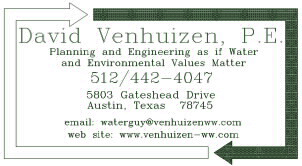Biofiltration Technology
A basic tool of the Decentralized Concept is “fail-safe” treatment technology. This term is presented in quotes because nothing is ever really, totally fail-safe, but certain technologies are, by virtue of their characteristics, inherently robust, resistant to “upsets” and other operational problems that would compromise treatment effectiveness or consistency. While each project has its own needs and requirements, in general it is my view, based on many years of considering a number of technologies, that recirculating biofilter technology is among the best – if not THE best – “workhorse” technology to use in distributed treatment systems where, due to the multiplicity of relatively small treatment units to be policed, this sort of highly robust, inherently stable technology is preferred in order to hold the total management effort to a “reasonable” level. This menu contains papers and an animated presentation that explain the high performance biofiltration concept, the variant of recirculating biofilter technology that I’ve “honed” over the years to produce a treatment concept that is as “fail-safe” as a high quality treatment process can practically be.
The High Performance Biofiltration Concept
Subtitled “The ‘Workhorse’ Technology of Distributed Treatment Systems”, this is the proceedings paper for a presentation on the high performance biofiltration concept at the 2008 NOWRA annual conference. It provides background of the generic technology, a detailed description of the treatment concept and its advantages, and examples of treatment systems employing this concept.
Nitrogen Reduction in Recirculating Biofilter Treatment Concepts
The proceedings paper for a presentation at the 2008 NOWRA pre-conference workshop on nitrogen management in small-scale wastewater systems, this paper provides a detailed review of the performance of 5 treatment systems subjected to a fairly intensive monitoring program in the Washington Island project, a demonstration project that “proved up” the denitrifying sand filter concept – which I subsequently honed to produce the high performance biofiltration concept – for the Wisconsin regulatory system. The paper reviews the treatment concept and its nitrogen removal performance, both theoretical and observed. Based on the observations, it can be concluded that this concept can consistently and reliably produce an effluent with ~15 mg/L of Total Nitrogen.
… to the High Performance Biofiltration/Drip Irrigation “Waste” Water Reclamation System. This paper reviews the experiences in the Washington Island project – it includes monthly summary data tables of BOD/TSS and nitrogen removal performance – and how they were used to hone the recirculating biofilter treatment process to produce the high performance biofiltration concept. A detailed review of how the concept is implemented for a single-home on-site wastewater system is provided, including a review of a drip irrigation dispersal system. An overview of system O&M is also provided. This system concept is suggested for broadscale implementation in Central Texas to deal with environmentally sensitive watersheds and to maximize reuse benefit of the reclaimed “waste” water.
System Animation – High Performance Biofiltration/Drip Irrigation
An animated overview of the design and operation of a high performance biofiltration treatment unit, discharging to a subsurface drip irrigation dispersal field. The animation runs on QuickTime and takes about 5 minutes to cycle through.
High Performance Biofiltration: Where Sand Filters Have Gone
While the explicit review of the treatment system concept offered in this paper has been superceded by the NOWRA paper on high performance biofiltration, this version – originally written in 2000 – offers a more detailed review of the developmental background of the technology, and also details the system design for a single-family home on-site wastewater system and the operations and maintenance of that system.
